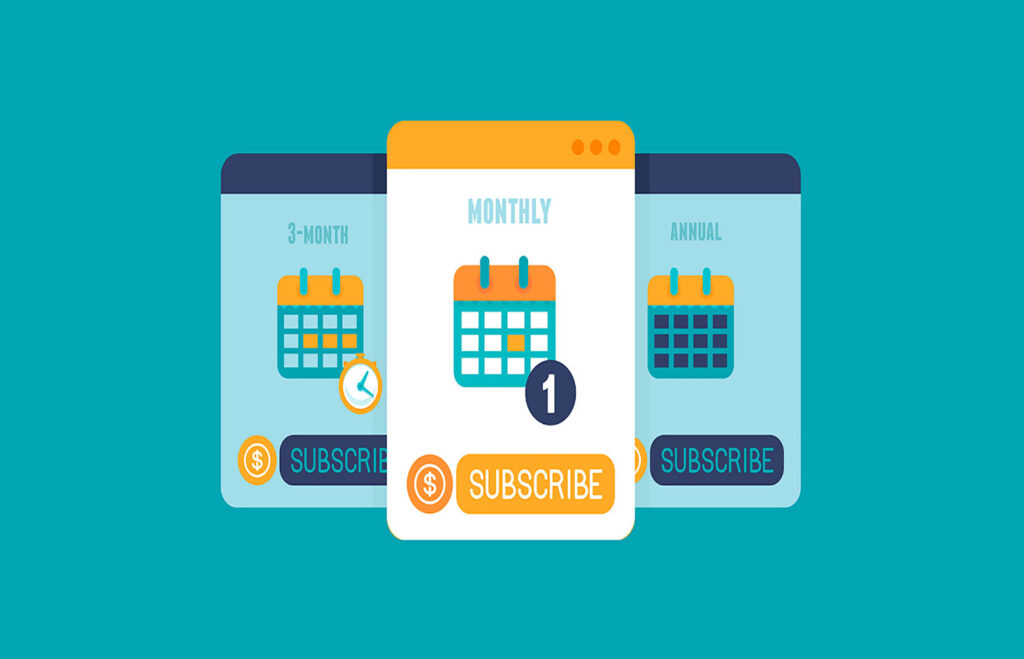When businesses shut their doors and sent workers home in 2020, the internet came to the rescue.
From videoconferencing to meal delivery, software and subscriptions were at the forefront of the response. What was already a growing business model erupted into the realm of necessary service. And the recurring revenue of the subscription model helped a lot of business get through the unprecedented times as well.
As shutdowns come to an end and people return to the office and a more ‘normal’ way of life, what will happen to the subscription explosion?
Will businesses and consumers cancel, no longer seeing a need? Or have subscription businesses proven themselves useful beyond social isolation mandates?
To find out, we dug into the numbers.
Here’s what the experts are saying about the future of the subscription business model.
Consumer subscriptions skyrocketed, but also earned scrutiny
At the onset of the pandemic, online spending reached a new high.
- Worldwide, people spent $82.5 billion online—a 77% increase in year-over-year growth.
- About $13 billion of this spending is attributed to subscription apps alone.
- Additionally, millions of people signed up for convenient B2C subscription box offerings from providers like HelloFresh, BarkBox, and Dollar Shave Club, among others.
- After 2020, budgeting app Truebill reports its average user now has 17 subscriptions, down from an average of 21 per user during shutdowns, but still up from the 2-3 most consumers enjoyed just a few years ago.
Truebill also reports little decline in food delivery and home workout subscriptions. This means that while the average consumer has fewer apps than they did during the pandemic, they’re still holding on to many of them. They certainly have significantly more than they had pre-2020, suggesting the subscription business model is here to stay.
That isn’t to say there won’t be challenges.
In recent years, consumer complaints about unclear subscription pricing, unexpected charges, and difficult-to-cancel subscription offerings have increased. This prompted federal regulators to look into the recurring revenue model.
The Federal Trade Commission has taken up lawsuits against subscription providers, which have popped up faster than the FTC can regulate. Even Apple has paid a $16.5 million settlement over claims of poor subscription business model practices.
With complaints racking up, many U.S. states and even credit card providers have begun imposing policies on the subscription business model. It may not be long before federal governments begin issuing their own regulations.
If that happens, it’s anyone’s guess what that will mean for growth.
It’s now almost impossible to do business without SaaS subscriptions
COVID-19 changed the way we do business, fast-tracking digital transformation across industries. Leaders and employees alike became more comfortable with videoconferencing and working exclusively in the cloud.
Now, many are returning to office spaces with these additional skills and abilities. Does that mean things will go back to the way they were?
It’s unlikely. Consider that:
- According to a McKinsey survey, 90% of B2B decision makers expect the remote and digital model to persist into the future. Three in four believe this model is as effective or more so than before COVID-19.
- Additionally, up to 80% of B2B decision makers now prefer remote human interactions or digital self-service. Their reasons include ease of scheduling, savings on travel expenses, and safety.
- TrustRadius also found 56% of businesses expect to spend the same amount of money or more on B2B tech in 2021 as before the pandemic. Most of this spending will focus on web and videoconferencing, online collaboration and project management, marketing, business intelligence, and customer support.
- One analysis by Dr. Yi Jin at Forbes determined that after reaching $200 billion in revenue in 2020 and $233 billion in 2022, SaaS will hit $369.4 billion in 2024.
While Jin’s is an optimistic prediction, even more conservative ones still expect B2B SaaS to continue to grow in the years ahead.
The SaaS business model made it possible for businesses to move to the cloud and continue operating through shutdowns. Platforms from Slack to Zoom, and Salesforce to Twilio played important roles in keeping economies functioning.
Businesses have rapidly progressed their digital agility, putting SaaS providers on the crest of the B2B subscription wave. The speed, convenience, and optimization potential of B2B SaaS is too valuable to ignore.
Some subscription business models are poised to thrive post-pandemic
As with any market disruption, some business models are better positioned for future success than others. When it comes to subscription businesses in a post-pandemic world, digital agility is a major differentiator.
Editorial publisher SaaSIndustry predicts a few SaaS business models are particularly well-poised to persevere in the years ahead.
- Online collaboration platforms. Zoom, Google Meet, and Microsoft Teams still make it possible for workers to meet anywhere with anyone. Additionally, Slack, Asana, and Jira keep teams connected and on track with projects regardless of whether they’re in office or working from home. The usefulness of these platforms ensures their ongoing success.
- Telemedicine. According to McKinsey, telehealth visits and outpatient care were 78 times higher in April 2020 compared to February 2020. As of February 2021, they had stabilized at 38 times higher. The same report revealed that 58% of physicians view telehealth more favorably than they did before the pandemic. Patients and healthcare staff enjoy the convenience and safety of remote appointments, keeping doctor’s offices uncrowded and efficient.
- Gaming and media. Subscription gaming and streaming services understandably saw increased usage in 2020. While there may be a dip in popularity as people get back to spending time out of the house, the online communities formed around online multiplayer games are a major draw. What’s more, gaming brands are taking on SaaS-like business models that draw players back in with regular updates and improvements.
Accelerated growth for the subscription business model will likely remain
The subscription business model has been through many iterations over the decades. Its current form is a reflection of market demands and the technology available today.
For subscription business leaders trying to make decisions for the future, it’s critical to understand post-pandemic customers and demand—and of course, their own demands in terms of recurring revenue.
Fortunately, the signs for both B2C and B2B subscription models are promising. While both may need to keep an eye out for future federal regulations, it’s clear subscription based apps, consumer boxes providing customers with food and consumables, and B2B SaaS subscription models are strong contenders for persevering in the years to come.








